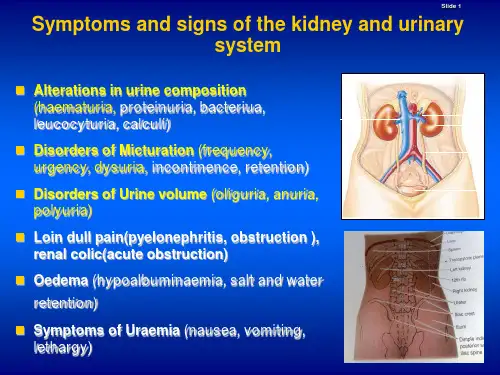Non-glomerular Hematuria From the renal pelvis, ureters, bladder, or urethra (urinary tracomerular Hematuria
GN or tubulointerstitial nephritis
Pathogenesis
Small breaks in the GBM
Rupture of tubular basement membrane Dysmorphic hematuria (>80%)
Fragmented, distorted RBC, knoblike projections (passing through gaps of GBM)
Slide 4
Definition of hematuria
Microscopic evaluation of urinary sediment: freshly voided (10ml), centrifuged (1500 rpm for 5 min) urine sediment: RBC3/HP on at least 2 out 3 collected specimens
Slide 5
Pseudohematuria
Menstruating female
Pigmenturia: presence of colored substance in the urine.
Endogenous: myoglobin (breakdown of muscle; pink,red,brown or black) Hemoglobulin
Slide 6
Causes of Hematuria
Kidney and urinary tract diseases Glomerulonephritis (GN): IgA nephropathy, Membranoproliferative GN, Crescentic GN,FSGS, Renal vasculitis. Lupus nephritis, Schonlein-Henoch nephritis, acute Poststreptococcal GN Infection: Pyelonephritis, Cystitis, Urethritis, prostatitis, TB Stone: kidney, Ureter, bladder, urethra Tumors: kidney, Ureter, bladder, prostate Hereditary disease: Alpert’s syndrome, Thin glomerular basement membrane nephropathy, Polycystic kidney disease Renal vessel diseases: Arterial emboli or thrombosis, Renal vein thrombosis, Arterial or venous malformation Others: Interstitial nephritis, papillary necrosis, trauma







